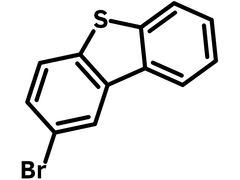2-Bromodibenzothiophene
CAS Number 22439-61-8
Chemistry Building Blocks, Heterocyclic Building Blocks, Materials, MonomersAn intermediate used for the synthesis of complex structures
Used commonly for semiconducting molecules, oligomers in application of OLEDs, OFETs and OPVs.
Specifications | MSDS | Literature and Reviews
2-Bromodibenzothiophene (CAS number 22439-61-8), mono-brominated dibenzothiophene at 2-postion, is commonly used as an intermediate for the further synthesis of more complex structures as organic semiconductors in light-emitting diodes, field-effect transistors and photovoltaic devices.
Bipolar 4,4′-bis(dibenzothiophene-S,S-dioxide-2-yl)triphenylamine (DSTPA), containing a strongly electron-withdrawing core and a strongly electron-donating core with a biphenyl bridge, has suitable HOMO and LUMO levels for easily accepting both holes and electrons. Having a high fluorescence quantum yield of 0.98 and a high triplet energy level of 2.39 eV, DSTPA can be used as green fluorescent emitter or host material for red phosphors [1].
9-(dibenzothiophen-2-yl)-3,6-bis(carbazol-9-yl)-9H-carbazole (DB2tCz), a host material synthesised from 2-bromodibenzothiophene and 3,6-bis(carbazol-9-yl)-9H-carbazole showed high glass transition temperature (Tg = 185 °C) and triplet energy level (ET = 2.93 eV). Vacuum deposited blue PhOLED device with FIrPic as the phosphorescence emitter and DB2tCz exhibited maximum current efficiency of 35.6 cd A−1, power efficiencies of 29.4 lm W−1, and external quantum efficiencies of 20.0% [2]
Dibenzothiophene building block
for the synthesis of OLED and organic photovoltaic materials
Worldwide shipping
Quick and reliable shipping
Substituted with a bromide group
for facile reactions
High purity
>98% Purity
General Information
| CAS Number | 22439-61-8 |
| Chemical Formula | C12H7BrS |
| Full Name | 2-Bromodibenzothiophene |
| Molecular Weight | 263.15 g/mol |
| Synonyms | 2-Bromodibenzo[b,d]thiophene |
| Classification / Family | Dibenzothiophene, Semiconductor synthesis intermediates, Low band gap polymers, OLED, OFETs, organic photovoltaics |
Chemical Structure
Product Details
| Purity | >98% (1H NMR) |
| Melting Point | Tm = 250-252 °C |
| Appearance | White to off-white powder/crystals |
MSDS Documentation
 2-Bromodibenzothiophene MSDS Sheet
2-Bromodibenzothiophene MSDS Sheet
Literature and Reviews
- A Bipolar Transporter as an Efficient Green Fluorescent Emitter and Host for Red Phosphors in Multi- and Single-Layer Organic Light-Emitting Diodes, J Ye et al., Chem. Eur. J., 20 (42), 13762-13769 (2014); DOI: 10.1002/chem.201402925.
- New sulfur-containing host materials for blue phosphorescent organic light-emitting diodes, J. Bin et al., J. Mater. Chem., 22, 21720-21726 (2012); DOI: 10.1039/C2JM34165D.
- Novel yellow phosphorescent iridium complexes with cycolmetalated (pyridin-2-yl)dibenzothiophene-S,S-dioxide ligands for singly doped emissive layer hybrid white organic light-emitting diodes, M. Luo et al., Opt. Mater., 91, 439-446 (2019); DOI: 10.1016/j.optmat.2019.04.006.

